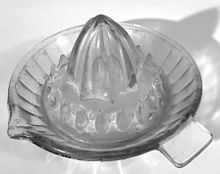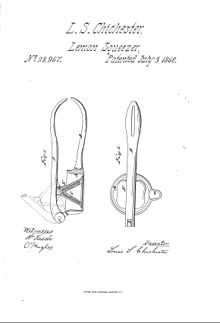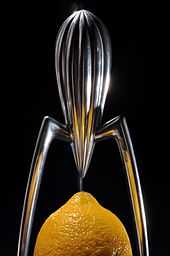Lemon squeezer

A lemon squeezer is a small kitchen utensil designed to extract juice from lemons or other citrus fruits such as oranges, grapefruit, or lime. It is designed to separate and crush the pulp of the fruit in a way that is easy to operate. Lemon squeezers can be made from any solid, acid-resistant material, such as plastic, glass, metal (usually aluminium) or ceramic.
History

The oldest known lemon squeezers were found in Kütahya, Turkey and date to the first quarter of the 18th century.[1] These ceramic presses are in the traditional style of Turkish pottery of the 18th century and have a superficial resemblance to today's press equipment with cones, though they are designed differently. These examples were individually made, and specially designed for making the then popular citrus drink sorbet. Lemons are not native to northern Turkey, though during the 17th and 18th centuries they were imported in bulk to Constantinople.[1]
At the end of the 19th century a large number of different models of lemon squeezers were patented in the United States. The U.S. Patent and Trademark Office lists over 200 patents for lemon squeezers, the majority of which were registered between 1880 and 1910. The oldest of these patents was issued to Lewis P. Chichester on July 3, 1860 for a cast iron squeezer. The stated purpose of the invention was "to obtain a simple, economical and durable implement whereby lemons may be squeezed for domestic purposes with much less power and with far greater facility than by the ordinary squeezers in general use."[2]
Functioning
The premise of the lemon squeezer is simple: Pressure is exerted on a lemon to force its juice and pulp from its rind; the juice and pulp often escape through a filter or sieve. The squeezer itself must resist the pressure, so soft, easily deformable materials cannot be used. Because the lemon juice is very acidic, the squeezer can only be made of acid-resistant materials.
Among squeezers that employ a twisting central projection, both manual and electric options exist; for the manual squeezer the operator must turn the device and hold the lemon (or turn and hold the lemon) while the electric squeezer turns it automatically and the operator must simply hold on to the lemon. Other squeezers simply crush the lemon against a stationary central projection; these usually employ long handles, to gain the mechanical advantage of a lever.
As a decorative object

Not all squeezers are actually meant to squeeze. Perhaps the most famous example of this is the Juicy Salif, designed by Philippe Starck in 1990. It is considered an icon of industrial design that has been displayed in New York's Museum of Modern Art. It is manufactured by Italian kitchenware company Alessi. Its diameter is 14 cm, height 29 cm, and it is made from cast and polished aluminium. As the founder of the company Alberto Alessi recalls "I received a napkin from Starck, on it among some incomprehensible marks (tomato sauce, in all likelihood) there were some sketches. Sketches of squid. They started on the left, and as they worked their way over to the right, they took on the unmistakable shape of what was to become the juicy salif. While eating a dish of squid and squeezing a lemon over it, Starck drew on the napkin his famous lemon squeezer." [3][4]
For the tenth anniversary of its launch, 10,000 were individually numbered and gold plated. There has also been a grey/black (Anthracite) coloured version of which 47,000 un-numbered examples were produced between 1991 and 2004.[5] Both now are collectors items, though an urban legend perpetuates that the anthracite version is rarer than the gold plated version.
The gold plated version was described as an ornament because the citric acid in a lemon discolors and erodes the gold plating. Starck even said his squeezer was, "not meant to squeeze lemons" but "to start conversations".[6]
See also
- Juicer
- Lemon reamer
References
- ↑ 1.0 1.1 John Carswell: "The Lemon-Squeezer; an Unique Form of Turkish Pottery" in IVème congrès international d’art turc, p. 29–45. Éditions de l’Université de Provence, Aix-en-Provence 1971, ISBN 2-85399-015-X
- ↑ US Patent No. 28967 at Google Patents
- ↑ Hive: Juicy Salif
- ↑ "'Juicy Salif' lemon squeezer by Philippe Starck for Alessi, 1990". Powerhouse Museum. 2000. Retrieved 27 November 2008.
- ↑ Alessi Company Archive
- ↑ Norman, Donald Arthur (2005). Emotional Design. Basic Books. p. 114. ISBN 0-465-05136-7.
External links
| Wikimedia Commons has media related to Lemon squeezers. |